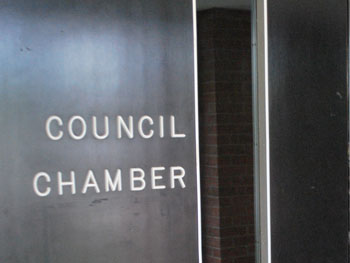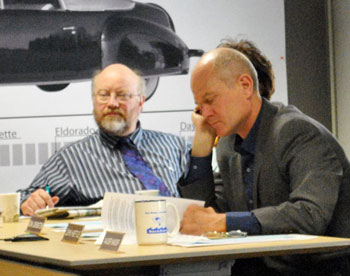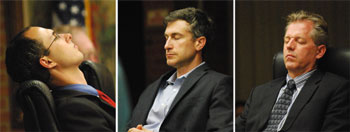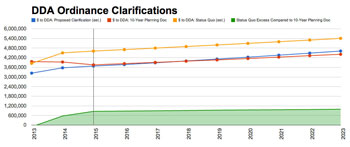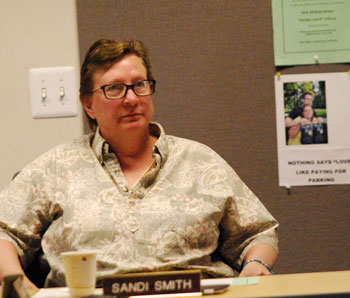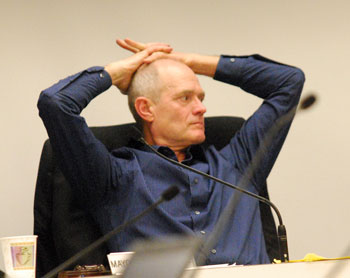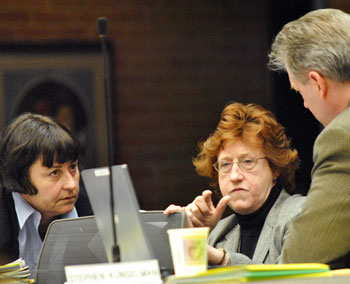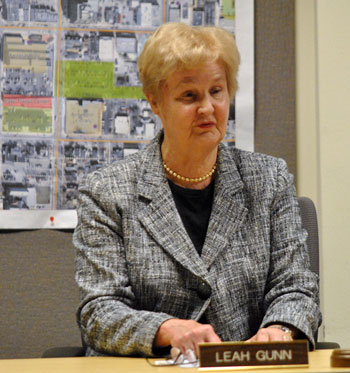Ann Arbor Downtown Development Authority monthly board meeting and annual meeting (July 3, 2013): In its voting business, the DDA board allocated a total of $550,000 for capital projects – either planning for future work or actual current projects.

Sandi Smith was elected by her colleagues as chair of the Ann Arbor Downtown Development Authority board at its July 3, 2013 annual meeting. Here she’s showing the DDA’s new website on her tablet. (Photos by the writer.)
The board also approved a $59,200 grant to support the formation of a business improvement zone in the South University area. A “trolley” for the upcoming art fairs also received $10,000 worth of support, in action taken by the board.
The capital projects included $50,000 for repair of sidewalk-related amenities that aren’t covered by the city’s sidewalk millage. In addition, the board allocated $200,000 for a streetscape framework planning project. Board action also included $300,000 for the replacement of light poles on Main Street.
The light pole replacement is one source of current friction between the city and the DDA – as the expectation of the city had been that the entire $516,000 project would be paid for by the DDA. But the result of wrangling over the DDA’s FY 2014 budget – given approval by the council on May 20 – was a transfer of $300,000 from the DDA’s TIF fund to the DDA’s housing fund. So the DDA’s position is that it can’t fund the entire light pole replacement project, because of that transfer to the housing fund.
The light pole question is related to the general issue of DDA finances and the revenue it receives through tax increment finance (TIF) capture of taxes – from entities that levy those taxes in the DDA district. Elected as chair at the annual meeting – which immediately followed the board’s monthly meeting – Sandi Smith will face the resolution of the TIF revenue issue as one of her first challenges.
The outstanding issue concerns the way that the DDA administers Chapter 7 of the city code of Ann Arbor – which regulates the DDA’s TIF capture. This spring the Ann Arbor city council gave initial approval to a revision to Chapter 7. The council’s action, if given final approval, would prevent the DDA from giving the code an interpretation that doesn’t recognize a cap on TIF revenue that is expressed in Chapter 7. The amendment to the ordinance would return several hundred thousand dollars a year to other taxing authorities from which the DDA captures taxes. Those entities include the Ann Arbor District Library, Washtenaw Community College, Washtenaw County and the city of Ann Arbor.
The council has postponed final action on the matter until Sept. 3, 2013. Between now and then, the council’s expectation is that a joint DDA-council committee will meet and make recommendations on the Chapter 7 issue.
At its July 1 meeting, the city council appointed four members to its committee: Christopher Taylor (Ward 3), Stephen Kunselman (Ward 3), Jane Lumm (Ward 2) and Sally Petersen (Ward 2). And at the July 3 monthly meeting, outgoing DDA board chair Leah Gunn appointed the DDA’s committee: Bob Guenzel, Roger Hewitt, Joan Lowenstein and Sandi Smith.
Another point of recent budgetary friction between the city and the DDA was raised briefly at the July 3 board meeting. In a formal resolution, the city council had encouraged the DDA to allocate money to fund downtown beat patrol police officers. For its part, the DDA has for a few years already been mulling the question of some kind of additional security – either in the form of ambassadors, community standards officers or police officers. At the July 3 meeting, DDA board members indicated they would continue to mull that range of options, but seemed disinclined to commit to funding police officers.
The board also heard a range of routine reports on July 3, including the monthly parking revenue report. The DDA manages the city’s public parking system under a contract with the city of Ann Arbor. In the future, it was announced, the report will be delivered only on a quarterly basis. Also related to parking policy, a tentative pilot project was announced that could change the basic approach the DDA takes to selling monthly parking permits. The idea would be to assign permit eligibility only to property owners in a defined geographic area. The number of permits would depend on the number of square feet of property – independent of uses such as office, residential, retail, etc. Currently, the DDA uses a first-come-first-served system for individuals, with a waiting list.
The DDA’s monthly meeting marked a transition on the board, as two board members were bid farewell. Newcombe Clark served one four-year term. He’s making an employment-related move to Chicago. Leah Gunn concluded nearly 22 years of service on the board. She finished out her time on the board as chair. [Full Story]







